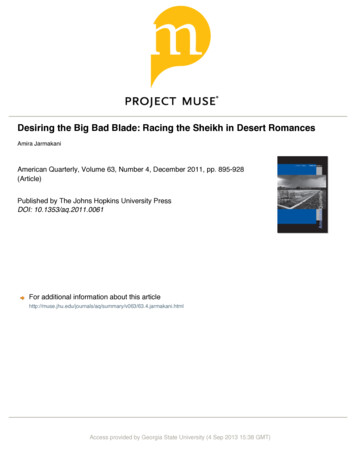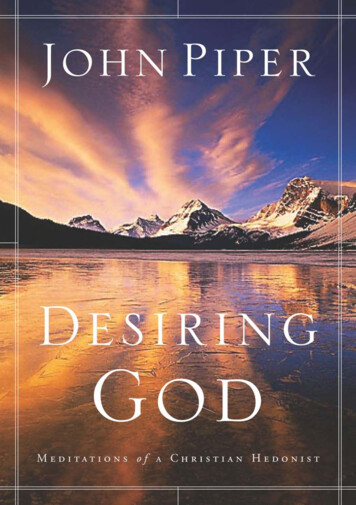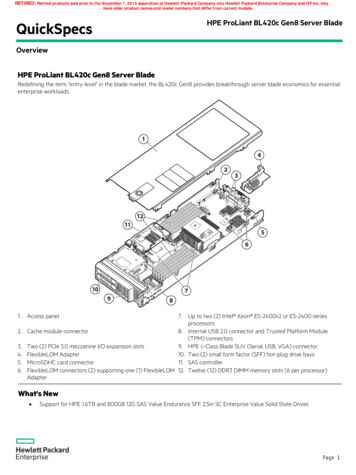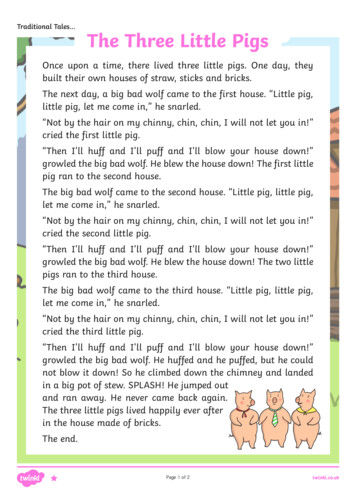
Transcription
Desiring the Big Bad Blade: Racing the Sheikh in Desert RomancesAmira JarmakaniAmerican Quarterly, Volume 63, Number 4, December 2011, pp. 895-928(Article)Published by The Johns Hopkins University PressDOI: 10.1353/aq.2011.0061For additional information about this 3/63.4.jarmakani.htmlAccess provided by Georgia State University (4 Sep 2013 15:38 GMT)
Racing the Sheikh in Desert Romances 895Desiring the Big Bad Blade: Racing theSheikh in Desert RomancesAmira JarmakaniCultural fantasy does not evade but confronts history.— Geraldine Heng, Empire of Magic: Medieval Romance and the Politics ofCultural FantasyIn a relatively small but nevertheless significant subgenre of romance novels,1 one may encounter a seemingly unlikely object of erotic attachment,a sheikh, sultan, or desert prince hero who almost always couples with awhite western woman.2 In the realm of mass-market romance novels, a booming industry, the sheikh-hero of any standard desert romance is but one ofthe many possible alpha-male heroes, and while he is certainly not the mostpopular alpha-male hero in the contemporary market, he maintains a nicheand even has a couple of blogs and an informative Web site devoted especiallyto him.3 Given popular perceptions of the Middle East as a threatening andoppressive place for women, it is perhaps not surprising that the heroine in apopular desert romance, Burning Love, characterizes her sheikh thusly: “Sharifwas an Arab. To him every woman was a slave, including her. He was a lawlessbarbarian.”4 Even if expected, though, such uncomfortable facts about herlove interest lead the heroine to struggle against her own attraction to himand to subsequently swear: “I’ll be damned if [he’ll] hoist me on [his] big badblade again!”5These revelations, of course, set up the erotic tension that structures thenarrative arc of the story; the author will spend the rest of the novel workingto convince the heroine and, through her, the reader that her understandingof Sharif had been based on a misunderstanding. Though the notion of Arabsin general as “lawless barbarians” who enslave women will not be dispelled,Sharif, in particular, will be revealed as a powerful and sexy male specimen whocan be tamed only by the heroine. His Middle Eastern background, thoughsafely resolved by the novel’s end, nevertheless is a constant reserve for his eroticpotential. Enter the “big, bad blade.” As a somewhat clumsy euphemism forhis penis, the reference to Sharif ’s big, bad blade actually illustrates a complex 2011 The American Studies Association
896 American Quarterlyinterplay of race and sexuality in constructing the sheikh as an erotic alphamale hero. The blade itself evokes a quite literal, if sheathed, reference to asword or scimitar, props that romance writers often use to simultaneously markthe sheikh as ethnically/racially different as well as aggressive and powerful.6Further, the conflation of dark and dangerous, signifying a conflation of raceand violence, in the sheikh’s eroticized sexuality functions according to longstanding U.S. racial logics that simultaneously uphold and disavow the linksbetween race and sexuality.7To some extent, these links can be seen in the romance genre as a whole.This is not to say that there is a plethora of nonwhite heroes in mass-marketromances; in fact, a common complaint among romance readers is the lack of“minorities” in romance and, in particular, of multiracial romances.8 However,because the most common type of hero is an alpha male—that is, a strong, hard,dominant and/or aggressive, confident man with a tender spot that the heroine uncovers9—authors sometimes use exotic tropes to give the hero his hardedges. In constructing the figure of the Latin lover, for instance, authors canmobilize mainstream assumptions about machismo to signify alpha maleness.In Native American heroes, romance authors can mobilize the fierce warriorstereotype to make him alpha and draw on typical “noble savage” associationsto craft his sensitive side for the heroine.10Desert romances fall roughly into this group of exoticized romance heroes,11a group that notably excludes the black hero. Far from being part of the raciallandscape of mainstream romance novels, black heroes can be found almostexclusively in African American category romance, published by presses likeKimani, an imprint of Harlequin, or Arabesque, also an imprint of Harlequin.The persistence of what seems to be a separate but equal clause in mass-marketromances speaks powerfully to both the unspoken presence of racial ideologiesin the romance genre and the lingering potency of stereotypes about violentblack masculinity. The balance between fantasy and reality that romanceauthors must strike manifests tellingly when it comes to race; nonwhite characters are either segregated or contained through various devices, while raceappears in phantasmic ways. More often than not, authors use the “chromaticassociations” of darkness and blackness in describing racially white heroes,12thereby incorporating metaphors that are deeply embedded in racial logics ofthe global North. In romance novels, then, the logics of racialization are oftensubsumed to those of eroticization, since race cannot usually be overtly coded,which is ironically what makes them such rich objects of study. They speakdirectly about the construction of race, gender, sexuality, religion, nation, andcivilization even as they claim to be universal and color-blind fantasy stories.
Racing the Sheikh in Desert Romances 897In focusing on representations of the sheikh-hero, I chart the discursiveconstruction of race in relation to Arabs and Muslims or, more generally,Middle Easterners. The figure of the sheikh is, in some ways, perfect for suchan inquiry, since his characterization mimics the conflation and confusion ofethnic (Arab), religious (Muslim), and geographic (Middle Eastern) markersthat construct Arabs/Muslims/Middle Easterners as a group in the UnitedStates. Desert romances are overwhelmingly set in fictionalized Arabia, withmost novels set in a country invented by the author; perhaps this liberty alsoemboldens the authors to confuse and combine references to the Gulf region,North Africa, Bedouins, Berbers, Arabic (the language), Iran, and Turkey.Though to some extent these kinds of conflations have characterized mainstream U.S. understandings of the Middle East since at least the nineteenthcentury, the configuration of the Arab/Muslim/Middle Easterner in the particular contexts of the war on terrorism (under presidents Ronald Reagan, GeorgeBush Sr., and Bill Clinton) and the war on terror (under presidents GeorgeBush Jr. and Barack Obama) has shifted in critical ways; it highlights religion(Islam) while invoking a racial paradigm of cultural/civilizational difference.Put simply, the logic of racialization applies to Arabs, Muslims, and anyoneperceived as such in the United States in newly visible ways. Following this shift,Arab American studies has taken the movement from discourses of invisibilityto hypervisibility as a critical point of inquiry. From Therese Saliba’s “ResistingInvisibility,” Nadine Naber’s “Ambiguous Insiders: An Investigation of ArabAmerican Invisibility,” and Helen Samhan’s “Not Quite White,” to Lisa SuhairMajaj’s “Arab Americans and the Meanings of Race,” Louise Cainkar’s Homeland Insecurity, and the collection of essays Race and Arab Americans before andafter 9/11: From Invisible Citizens to Visible Subjects, edited by Amaney Jamaland Nadine Naber, scholars have been concerned with a palpable transformation in how Arab Americans and Muslim Americans fit into the landscape ofU.S. racial formations. These scholars have noted, in particular, the increasingracialization of Arab Americans and Muslim Americans since at least the 1965Immigration Act, after which a greater number of Arabs and Muslims wereable to immigrate to the United States.While these material considerations are crucial to analyses of Arab/MuslimAmericans and race, an equally compelling, and relatively unexplored, area ofinquiry is the role of representation in the racial formations of Arab/MuslimAmericans. Such scholars as Evelyn Alsultany and Edward Said have analyzedthe shifting racialization of Arabs and Muslims in popular (television dramaand news media) representations;13 here I build on their scholarship by demonstrating the racialization of representational Arabs and Muslims through
898 American Quarterlycharacteristics that had previously been understood as ethnic, religious, orregional.In doing so, I take aim at the notion of race as a discrete category, sometimes employed even in intersectional analyses, and instead posit it as a partial,diffuse, and porous category, shot through with the residual constructions ofethnicity, sexuality, religion, culture, and civilization (to name a few). Whilesome scholars have offered alternatives to the intersectionality paradigm, suchas “assemblage” and “categorical miscegenation,”14 I offer the metaphor of radiation as a way to think about race vis-à-vis Arabs and Muslims in the UnitedStates. As several desert romance plots reveal,15 the Middle East is popularlyassociated with the radiation involved in nuclear enrichment—the “bad guys”in both contemporary mainstream news media and in many desert romancesseek to illegally find ways to enrich uranium and make nuclear weapons.This way to construct a clear enemy aids in racializing that enemy; featuresthat may or may not logically cohere a group (e.g., geographic location inthe case of Iran and Iraq) nevertheless construct that group within the sameracial formation for a U.S. audience. On a metaphoric level, radiation suggests how racial logics can silently and invisibly permeate ethnic, religious, andcultural categories in potentially deadly ways (taken to its extreme in the casesof murdered Arabs, Muslims, and Sikhs in the aftermath of 9/11). While itcan operate in silent and invisible ways, though, it nevertheless has materialeffects. The failure of various nuclear reactors (most recently in Japan) hasunfortunately demonstrated that radiation permeates much larger areas thanoften admitted or acknowledged, and though its presence may be very real,its effects are often not evident until long after the first exposure. Preciselybecause the effects of exposure can be so hard to chart, I look in what seemsto be the unlikeliest of places: fantasy stories that have an invested interest indownplaying race. To put the metaphor to use in another way, then, I givean X-ray reading of desert romances, outlining the skeleton of racial logic onwhich the flesh of the story hangs.Despite the old adage, the book covers of popular desert romances revealsome interesting things about the way the sheikh is coded for popular consumption. Among contemporary mass-market romances, beginning in the late 1960sand continuing to the present, the book covers demonstrate a remarkable inversion of how Arab and Muslim men have been racialized in the United States.Whereas early desert romances utilize the exoticized marker of the kuffiyeh orghutrah and igal—colloquially known as a “headdress”—to adorn the sheikhon the cover,16 recent romances, particularly since the events of September 11,2001, are careful to represent the sheikh as abstractly Mediterranean with no
Racing the Sheikh in Desert Romances 899Figure 1.Firgure 2.Charlotte Lamb, Desert Barbarian. New York:Harlequin, 1978. Reprinted with permission fromHarlequin.Linda Conrad, Secret Agent Sheik. New York:Harlequin, 2011. Reprinted with permission fromHarlequin.clear markers of his connection to “Arabia.” The transition to the unmarkedMediterranean sheikh-hero on the cover highlights a distinctive feature of theromance novel genre; the narratives must negotiate a delicate balance betweenfantasy and (perceived) reality. By displaying the sheikh-hero in a ghutrah, theearlier desert romance novel covers emphasize cultural markers that clearlyidentify the sheikh as exotic other; at the same time, they reference the filmicrepresentation of “Lawrence of Arabia,”17 an object of fantasy for fans of thedesert romance.In the context of the 1970s and 1980s, the Lawrence of Arabia fantasy seemsto have been a prominent enough association with the Middle East that therewas no danger of readers connecting the sheikh-hero with the unpleasant political realities of U.S. engagement in the region. However, at least since 2001,when swarthy men in headdresses call up a much more disturbing associationwith the Middle East for mainstream readers, romance novel covers avoid such
900 American Quarterlyovert references to the sheikh-hero’s otherness, in what seems to be an effortto protect readers from too much reality. In this complex dialectic betweenfantasy and reality lies an interesting commentary about the racialization ofthe sheikh, which, in turn, implies a shift in the racialization of Arabs andMuslims in the United States.A close analysis of (both positive and negative) engagements with desertromances online coupled with a textual analysis of some of the novels demonstrates that an inversion in overt representations of ethnic and religiousmarkers for fictional sheikhs ironically signals a shift toward the more overtracialization of actual Arabs and Muslims in the United States. Since (overt)discussions of race are generally irreconcilable with fantasy in romancelandia,the disappearance of the sheikh’s headdress on the covers of desert romancessuggests its transformation from a widely perceived ethnic marker to a widelyperceived racial marker.18Interestingly, one of the only book covers to display a sheikh in a ghutrahand igal after 2001 is Delaney’s Desert Sheikh, the only desert romance to feature an African American heroine.19 Like the vast majority of white heroinesin desert romances, Delaney is drawn to Sheikh Jamal’s “native Arab garb,”but she is also attracted to the “rich-caramel coloring of his skin, giving truemeaning to the description of tall, dark, and handsome.”20 The attention toa phenotypical description of skin color, replicated in a scene in which Jamalimagines the “dark, copper-colored skin, head of jet-black curls, and darkchocolate colored eyes” of his future son,21 is virtually nonexistent in mostdesert romances, particularly in novels from the last decade, a detail thathighlights the complex relationship between popular notions of race and thefantasy world of the novel. In the racially stratified world of romance novels,the representation of Jamal’s headdress on the cover of Delaney’s Desert Sheikhparallels the interior description of him as a man of color to eroticize him forthe intended audience. On the contrary, though the sheikh character has a longhistory of commodification in the United States, what makes him consumablefor a mainstream white audience in the post-9/11 context is a submersion ofovert racial markers, precisely because actual Arabs and Muslims in the U.S.landscape are irradiated with racial logics in newly intense and legible ways.What were previously employed as exoticizing ethnic, religious, or culturalmarkers of the sheikh’s desirability now glow with the potential threat of racialovertones.I do not wish to imply that racialization is a new phenomenon for ArabAmericans and Muslim Americans, as if there had been a clear, distinct switchfrom the paradigm of ethnicity to that of race in the last decade. On the con-
Racing the Sheikh in Desert Romances 901trary, race has functioned as a submergedlogic in the construction of Arab Americansin particular since the first wave of immigration in the late 1800s.22 Nevertheless, I dochart the increased salience of the concept of race to the construction of ArabAmericans and Muslim Americans, noting how more recent configurationsof the group operate in more overtly racialized ways. Underlying all of thisare two basic ideas laid out by Michael Omi and Howard Winant in theirlandmark book Racial Formations in the United States: (1) that race presentsitself as an immutable, fixed, and natural characteristic, despite being a sociohistorical concept; and (2) that racialization is a historically specific ideologicalprocess, which sometimes “extends racial meaning to a previously unclassifiedrelationship, social practice, or group.”23 The first point serves as a reminder ofthe persistent recourse to the natural and essential (or, especially in scientificiterations, the biological) in discourses of race;24 the second point highlightshow organizing elements like ethnicity, religion, or geopolitical configurationsFigure 3.Brenda Jackson, Delaney’s Desert Sheikh.New York: Silhouette, 2002. Reprintedwith permission from Harlequin.
902 American Quarterlycan become racialized while noting that a set of political investments generallyaids such a process.There is no easy or shorthand way to refer to the racialization of ArabAmericans and Muslim Americans, which helps further elucidate the abovetwo points. In reality, one must speak of the racialization of Arabs, Muslims,and anyone appearing to be Arab or Muslim in the United States. That lastclause, the hardest aspect of this particular racial formation to signify in a neatphrase, suggests, again, that “common-sense” notions of race fall back on vagueassignations of “type and descent” and tend to (or try to) naturalize a culturalgrouping.25 In this respect, it seems to follow Paul Gilroy’s suggestion that racecontemporarily functions according to “culture lines rather than color lines.”26At the same time, one can hardly speak of Arabs, Muslims, South Asians,Iranians, and anyone appearing to be any of the above as one cultural group,proving that racial notions are rooted in ideological processes, in this case in apolitical investment that constructs a disparate group formation, which somescholars refer to as Arab/Middle Eastern/Muslim,27 as enemies of the state.Here it is clear that ethnicity and race are not mutually exclusive, as race servesto contain and/or manage ethnic and religious identities. Race is a famouslyunstable concept, which often uses a variety of categorizations in its service.Siobhan Somerville has noted, for instance, that “in 19th-century scientificusage, [race] might refer to groupings based variously on geography, religion,class, or color.”28 In the Arab/Muslim/Middle Eastern configuration, it isprecisely such kinds of groupings that are at play—the configuration seemsto refer at once to ethnicity, religion, and geopolitical territory—implyingthat the conflation of these kinds of groupings is itself a characteristic of theconcept and functioning of race. I refer here to its fluidity and its flexibility,in terms of both space and time. Though I focus on modern notions of race,it must be noted that contemporary constructions of Arabs/Muslims/MiddleEasterners seem to incorporate atavistic, protoracial formations of the Muslimother, rendered through narratives of the Crusades, and especially the Inquisition and the Reconquista in the Iberian peninsula.29Given its fungibility, I work from a definition of race suggested by Winantin The New Politics of Race: “Race is a concept that signifies and symbolizessociopolitical conflicts and interests in reference to different types of bodies.”30This definition offers two points of departure—one related to bodies and onerelated to architecture. Though some phenotypical characteristics, like darkskin or a long beard, certainly play a role in racializing Arabs and Muslims inthe United States, one must also take “bodies” to include notions of bodiesthat understand their embodiment to be shaped by racially marked, habitually
Racing the Sheikh in Desert Romances 903worn sartorial items (like a hijab31 or turban) as well as habitually performedmovements (like salaat, the Muslim practice of praying five times a day).The example of the Sikh turban brings together several elements of racialization I have sought to delineate. Being neither Arab nor Muslim nor MiddleEastern, Sikh men inhabit the often unstated clause of the Arab/Muslim/Middle Eastern formation—they are those appearing to be such (according tomainstream perceptions) based partly on a racially marked, habitually worn,item of clothing. Likely assigned to the vague term headdress by popular U.S.imagination, the racialization of (and violence against) Sikh men in the UnitedStates after 9/11 also points to the particular architecture of this racial logic—itis designed and built on U.S. military conflict, the “war on terror,” and theconstruction of the enemy of the state par excellence—the terrorist. While adiscussion of the construction of the term terrorist and the uses to which it hasbeen put is outside the scope of this article, the point is that it serves as a way tosystematize a whole set of state policies—classification, surveillance, strategiesof punishment and detention, and distribution of resources—that are metedout along racial lines;32 in this case, it also codifies the Arab/Muslim/MiddleEastern configuration through the specter of the terrorist, as a racial formation.Rather than entirely new, this racial formation constructs peoples with ancestry in the SWANA (South and West Asia and North Africa) region in newlylegible ways. As Melani McAlister points out in Epic Encounters, the MiddleEast has figured in U.S. national mythologies in various ways. These mythologies, in turn, configure race differently from one another. In identificationswith the “Holy Land” as an origin of “Western civilization,” popular in thelate nineteenth century and into the turn of the century33 and then again inthe post–World War II period34 (though never fully receding),35 peoples of theMiddle East tend to be relegated to atavistic elements of the landscape. Insofaras the Middle East has played the representational role of the other in the U.S.progress narrative (e.g., in the belly dance exhibitions at the 1893 ChicagoWorld’s Fair, which demonstrated U.S. progress and prowess, in part, againstthe ethnographic/spectacular exhibits of others),36 peoples of the Middle Easthave often been assigned a quaint, atavistic, or timeless status.Even in representations that provoke—such as belly dancing at the fair,which both attracted and repulsed viewers because of its flouting of Victorianideals of white femininity—the Middle East appeared distant and containable,able to be inspected and gazed on, but ultimately controlled. In a third typeof U.S. discourse, that of national security, the Middle East figures in bothmaterial and representational ways, both of which construct Middle Easterners,and especially Arab Americans and Muslim Americans, as a threatening pres-
904 American Quarterlyence.37 Though this discourse obviously incorporates the figure of the terroristas primary enemy of state in the contemporary context, it is also imbricated inthe idea that access to natural resources (such as oil) is a primary concern ofnational security. It is this configuration that turns Arabs and Muslims towarda threatening presence formation, beginning at least with the 1973 oil embargoand accelerating into the Reagan/Bush/Clinton-era war on terrorism as well asthe Bush/Obama war on terror. As an object of state regulation and surveillancein newly highlighted ways, particularly after the events of September 11, thefigure of the Arab/Muslim/Middle Eastern/terrorist is therefore more overtlysubjected to a political, ideological, and systemic form of racial classification.The character as a—broadly conceived—fits into this landscape in multipleways.38 In romance novels, he portrays both noble savage and violent, primitiveother (in the form of the antihero) of the progress narrative. He is the wealthy,dashing sheikh of his own oil-rich kingdom and the rich, greedy oil sheikh ofthe 1973 oil embargo,39 both incarnations of the national security discourse.One could even argue that the way the desert is constructed through tropes offreedom in the novels draws on the mythology of the U.S. relationship to theHoly Land. However, the figure of the sheikh has been rendered most overtlythrough his signification of a particularly aggressive and eroticized sexuality,where, as noted earlier, his sexuality depends on a clear link between eroticismand an ethnicity containing a liminal racial logic.40 Such liminality, in turn,allows romance writers to negotiate a fine line between fantasy and reality; thesheikh-hero evades the threat of racial identification (as race would destroythe fantasy) through inscription (or escape) into the ethnic/erotic realm andthrough simultaneous submersion of markers of race.I trace the way ethnic inscription and racial submersion function throughan analysis of two discursive realms. In the first realm, posts and discussionson popular romance novel blogs, readers cannot get past the (raced) realitiesof the sheikh-hero to fall in love with him. Here, then, I chart the failed submersion of racial logic for some (potential) readers of desert romances, notingin particular how they characterize this as a new phenomenon. In the secondrealm, I analyze desert romances themselves to demonstrate how they submergerace to ethnicity to successfully interpellate readers into the world of fantasy.The Sheikh: Fantasy or Reality?Romance novels are widely considered to be escapist fiction, offering readersreprieve from their own unexciting, everyday realities. Many readers confirmsuch an assumption on popular blogs and message boards devoted to the genre.
Racing the Sheikh in Desert Romances 905Perhaps this is why both readers and writers of the desert romance deny anyrelationship between its popularity and the resurgence of the war on terror,despite the fact that desert romance publication has remained steady, if notelevated, since 2001. As some of the respondents to “The Unshakeable Appealof the Sheikh Hero” say: “I never even thought about the current problems inthe MidEast (“terrorism,” theocracy, etc.) in relation to my absolute obsessionwith Sheikhs. . . . I think my love for Sheikhs is because of their ‘alpha maleness’as it is described,” and “I don’t think about 911 [sic] when reading sheikhs.”41Trish Morey, author of Stolen by the Sheikh and The Sheikh’s Convenient Virgin,puts it perhaps less pointedly, but more helpfully as she contextualizes the claimof distance from current political events: “I just love the escapism and sheerfantasy of the sheikh story. I think EM Hull got it so right when she pennedher famous ‘The Sheik’ about a century ago. Being whisked away by the kingof the desert is a theme that resonates with women all over.”42 Here Moreymakes a point related to “escapism and sheer fantasy” that is key to the popularnarrative of the sheikh-hero and to romance novels in general.While romance novel enthusiasts are quick to point out that romance novelsare not only about escapism, when the novels tread too closely to the “real”world, readers and writers carefully guard fiction’s escapist element. After all,they reason, they can (and must) engage with “real world” drudgery everyday, which is why they turn to fantasy in the first place. Therefore, as JaniceRadway has pointed out and as readers will confirm, romance novels actuallydemonstrate a complex interplay between notions of fantasy and reality.43Radway argues that romance readers expect to learn some “real” historicaland geographic facts, even if the romance story itself is fictional, and, indeed,authors’ relative success at incorporating historical and cultural research intotheir novels is often a topic for discussion among readers. The tension betweenreaders’ expectations around the balance between fantasy and reality oftensurfaces in relation to a popular debate among romance readers about thefunction of rape and rape fantasy (as well as the difference between the two) inromance novels. In one online discussion, to which I return below, one readerexpresses the desire “to talk about issues of historical accuracy and authenticityin ways that allow us to confront the place we want more realism.”44 Whilethis reader is interested in acknowledging the contingencies of “reality” withinromance fiction, though, her interlocutors seem to reify a vague, commonsensenotion of the line between fantasy and reality. Most readers (in this thread)insist that reality in the story does not work when it “hits too close to home”and forecloses the possibility for fantasy, while relatively few are interested inexploring the shared cultural assumptions and sociopolitical realities that makesome details more unbearably “real” than others.
906 American QuarterlyOf course, it is precisely in the unspoken and subtle negotiations betweenfantasy and reality that romance novels do some of their most important culturalwork, since, as Geraldine Heng suggests, the genre of romance can provide asafe venue in which to explore larger cultural transformations.45 Particularlysince desert romances both enjoy a long history and maintain their popularitydespite the demonization of Arab/Muslim masculinity during the war on terror,they offer a set of materials through which to analyze the shifts in racializationof Arabs and Muslims. As Heng notes: “Race itself, after all, is a fantasy withfully material effects and consequences.”46 Since romance novels are famousfor eliding considerations of race, presenting themselves instead as universallove stories, they provide in their very disavowal a complex articulation of theconstruction of race. Even in the desert romance subgenre, in which the exoticother is the object of fantasy, overt references to race or racialization are hardto find, since, presumably, they would touch too closely on the realities thatreaders want to leave behind. Rather, covert articulations of race, sometimescoded through the tropes of ethnicity or region, play a
els,1 one may encounter a seemingly unlikely object of erotic attachment, a sheikh, sultan, or desert prince hero who almost always couples with a white western woman.2 In the realm of mass-market romance novels, a boom-ing industry, the sheikh-hero of any standard desert romance is but one of . Despite the old adage, the book covers of .











